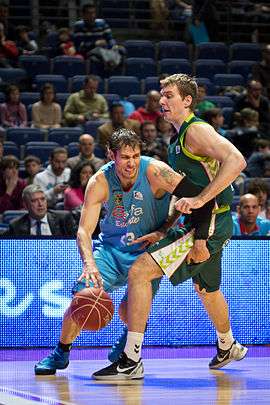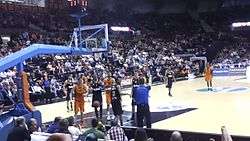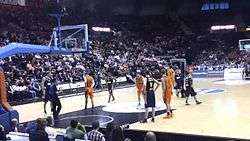Personal foul (basketball)

In basketball, a personal foul is a breach of the rules that concerns illegal personal contact with an opponent. It is the most common type of foul in basketball. A foul out occurs when a player exceeds his or her personal foul limit for a game and is disqualified from participation in the remainder of the game.
Players routinely initiate illegal contact to purposely affect the play, hoping it is seen as too minor to be called a foul. The threshold is subjective and varies among officials and from game to game. Most contact fouls are not regarded as unsportsmanlike. However, a contact foul involving excessive or unjustified contact is classed as an unsportsmanlike foul (or in the NBA, flagrant foul)
History
Basketball has always had the concept of fouls. In 1891, James Naismith's original 13 rules[1] defined a foul as:
- running with the ball,
- holding the ball with the arms or body,
- striking the ball with the fist,
- shouldering, holding, pushing, striking or tripping in any way of an opponent.
Only the fourth definition remains. Running with the ball and striking it with the fist are now violations. Holding the ball with the arms or body is now rare but legal.
Originally, on a player's second foul, the player would be removed without substitution until the next successful goal (similar to a penalty in ice hockey). Before long, free throws were introduced, originally worth three points each, then one. Originally, any team member was allowed to shoot free throws. In 1924, the rules were changed so that the fouled player shot the free throws.
The victim of a contact foul used to be given three attempts at a free throw, and retained possession of the basketball. Now, a player fouled in the act of shooting gets as many free throws as the point value of the shot he or she attempted (except that, if the shot was successful, the player takes one free throw).
Principles
Personal contact does not necessarily constitute a personal foul, unless it gives a player an advantage or puts the opponent at a disadvantage.
Cylinder
In FIBA, the cylinder principle gives each player exclusive rights within an imaginary cylinder defined:
- in the front by the palms of the hands, when the arms are bent at the elbows so that the forearms and hands are raised, but no farther in front than the feet,
- in the rear by the buttocks,
- at the sides by the outside edge of the arms and legs.
The cylinder extends from the floor to the ceiling, allowing the player to jump upward.
A player can occupy any cylinder not already occupied by the opponent. No one else is allowed to step or reach into this cylinder. A player must not extend his limbs or bend his body in a way that is not normal. If there is a breach of this principle that places the opponent at a disadvantage, the official may penalise it.
The NBA does not use the cylinder principle to judge contact; it only says that a player may not bend or reach in a position that is not normal (nor push, hold, and so on).
Elements of time and distance
The elements of time and distance concern the reaction time and distance of another person. They apply only to players without the ball, not to the ball carrier. For example, a player cannot suddenly step in front of a sprinting player, even without invading the cylinder. Another example is when a player sets a screen directly behind a player: the player would not physically be able to react to the screen in enough time to avoid it.
Types of foul

Charging and blocking
When significant[n 1] illegal contact between the ball-carrier and a defender occurs, it usually means that either —
- The defender committed a blocking foul, or
- The ball-carrier committed the offensive foul of charging.
Deciding between the two is complex, partly subjective, and often controversial.
Generally, the ball-carrier committed a charge if all of the following are true:
- The defender was still, or moving sideways or backward but not forward, when contact occurred.
- The defender took a legal guarding position before the contact, that is, one with both feet on the floor.
- The defender was hit on the torso (as opposed to the arm or leg).
In the NBA, in contact during a move to the basket, officials do not consider the position of the defender's feet, but decide whether the defensive player's torso was set in position before the offensive player began his upward motion.[2]
A charging foul is usually not called if the ball-handler is within a 4-foot (1.22 m) radius around the center of the basket (known in the rules as the "restricted area" and sometimes colloquially as the "smiley face"[3]). That is, if the ball-carrier is under the basket, the defense usually cannot restrict his or her movement by drawing a charge. An exception is made if the offensive player receives the ball within an area close to the basket known as the "lower defensive box."
A related call is the player control foul.[n 2]
- Strategy
Apart from using hands in neutral space to shield or deflect a pass or a shot, the defender uses his or her body to impede the ball-carrier's advance toward the basket. The defender's only absolute way to achieve this is to stand directly in the ball-carrier's path and "draw a charge." Short of this, the defender's use of the body may make the ball-carrier hesitate or change tactics. Both opponents are restrained by their desire not to commit a foul.
It is not a foul to grab for the ball, or to touch a hand of the ball-carrier that is on the ball, but the ball-carrier, especially in the act of shooting, can easily cause greater contact that is a blocking foul against the defender.
Once contact is made, the defender may fall to the ground to exaggerate the force of the collision and induce a foul to be called. (The ball-carrier rarely does so, as it would disrupt the effort to score a goal.) Overt deception is disparagingly called a "flop" and is discouraged by the rules at every level of basketball.
- Screening
A screen is an attempt by an offensive player to stop a defender from guarding the ball-carrier. For example, John Stockton and Karl Malone were well known for their pick and roll (or screen and roll) play. The ball-carrier's teammate is the screener; he stands in the path of the defender as the ball-carrier dribbles past the screener. This at least costs the defender time, and may induce a collision. Either leaves the ball-carrier unguarded. However, if the screener moves towards the ball-carrier when contact occurs, or does not respect the elements of time and distance, or initiates contact, he is charged with illegal screening or setting a moving pick. These are blocking fouls.
Other fouls on the ball-carrier
In the NBA, the ball-carrier cannot attempt to dribble past a defender where there is not enough space, such as dribbling between a defender and either a boundary or another defensive player. If the ball-carrier has space to put head and shoulders past the defender, then the defender is responsible.
In FIBA, this rule is not codified, but contact caused by the dribbler is still penalized.
Fouls away from the ball
The rules are symmetrical for contact between offensive and defensive players not involving the ball-carrier. Any player has the right to a position on the court legally acquired. A player acquiring a position that will impede an opponent must respect the elements of time and distance; that is, not take a position so close, or so quickly, that the opponent cannot avoid contact. This includes gradually slowing down after running with the opponent, and situations where the opponent is shielded from seeing the player's movement.
Other personal fouls
- Pushing — Contact that displaces an opponent (for example, pushing a player away from the basket, or using body weight to affect a player's movement).
- Holding — Contact that interferes with a player's freedom of movement (for example, physically grabbing a player driving to the basket).
- Illegal use of hands — Extending the hands outside the cylinder and causing illegal contact (for example, going for a steal but hitting the player's hand or arm, or hitting the arm of a shooter).
- Hand-checking — Contact by the defense on a ball handler that impedes a player's speed, quickness, rhythm, and/or balance.
- Illegal use of elbow — Moving one's elbow outside the cylinder to disadvantage an opponent. This mostly occurs during a post-up play situation, where either offense or defense attempt to gain a better position.
- Illegal use of legs or knees (on the dunk): Jumping up with one knee forward as to intentionally hit the defender.
Non-foul
Referees who called every case of illegal player contact would dominate the game to the exclusion of the athletes, but reluctance to make calls would make the game excessively violent. The rules direct referees to seek a balance between these extremes, though they do not define it.[n 3]
When players are competing for a ball that goes out of bounds, and one player commits illegal but minor contact, referees often do not feel a foul is justified but resolve the situation by simply awarding possession of the ball to the other team.
The "reach-in foul" is a misnomer. Reaching toward a player is not a foul, though physical contact may be a foul.
Penalties
The official scorer records the foul in two counts of fouls on the scoresheet:
- As a player foul against the offending player during the game. A player who accumulates too many fouls will foul out (see below).
- As a team foul against the offending player's team during the current quarter or half. A team that accumulates too many fouls in that period enters the penalty situation and puts the other team into the "bonus." In college basketball, another, higher number of team fouls gives the other team a "double bonus" (men only) regarding the number of free throws. (See the article on free throws.)
On a foul committed by the defense (and on a loose-ball foul when neither team is in possession of the ball), if the team committing the foul is in the penalty situation or the fouled player was in the act of shooting, the fouled player is awarded free throws. Otherwise, and on offensive fouls, the fouled player's team is awarded possession of the ball to pass inbounds from the out-of-bounds point nearest to the foul. The shot clock is reset.
In some rulebooks, such as that of FIBA, a technical foul is included in the count of player fouls.
If the game goes to overtime, counts of player fouls are not reset, but each overtime period has its own count of team fouls.
Strategy

Fans and commentators often call an infraction a "good foul," such as when the foul is against a player who would otherwise have made a sure basket. By fouling the player and preventing an easy two points, the defender forces the offensive player to "earn" the two points from the free throw line. However, if the foul does not prevent the player from scoring, the basket is counted and the fouled player gets an additional free throw.
After the fouled player shoots free throws, the team that was on defense is likely to gain possession of the ball. This is by award, if the final free throw was made. Even if it is missed, defensive players can occupy better positions at the side of the lane to get the rebound.
Near the end of the game, a team that is losing may purposefully foul offensive players to stop the clock and regain possession of the ball, with the hope that the player will miss his free throws. Coaches study free-throw percentages, so that the defense will foul a ball carrier who is poor at free-throw shooting. The "Hack-a-Shaq" strategy was famously practiced against Shaquille O'Neal in view of his poor percentage. The defense is not free to foul its choice of the five offensive players, as a foul "away from the ball" results in free throws plus possession.
- Clear path fouls
In the NBA, it also results in free throws plus possession when the defense commits a foul and the ball carrier is in the frontcourt with a "clear path" to the basket (no defender between the ball carrier and the basket).[4]
Fouling out
A player who commits five personal fouls over the course of a 40-minute game,[n 4] or six in a 48-minute game, fouls out and is disqualified for the remainder of the game. A player within one or two fouls of fouling out is in "foul trouble." Players who foul out are not ejected and may remain in the bench area for the remainder of the game. Fouling out of a game is not a disciplinary action.
In the NCAA and FIBA, if a team is reduced to five players by injury or ejection, and one of them commits a sixth foul or is ejected, play continues with that team reduced to four players.
In the NBA and WNBA, no team can be reduced to four players, so such a player stays in the game. If another of the five players is ejected or injured, the last player to foul out rejoins the game. In these reinsertions, the team is assessed a technical foul. In addition, any additional foul the player commits draws another technical foul. This results in one or an extra free throw for the opponents, even if the player's foul would not normally result in free throws. (These technical fouls are not for unsportsmanlike conduct, so they do not result in ejections from the game.)
This rule let Don Otten set the NBA record for personal fouls in a regular-season game. He had eight fouls while playing for the Tri-Cities Blackhawks (now the Atlanta Hawks) against the Sheboygan Red Skins on November 24, 1949.[5] The rule was again invoked in a game between the Los Angeles Lakers and Cleveland Cavaliers on February 5, 2014.[6] With the Lakers down to 5 players due to injuries, when Robert Sacre fouled out, he remained in the game.[7]
Notes
- ↑ The NBA rulebook (officiating guidelines, Section C) repeatedly excludes "negligible and/or incidental....contact".
- ↑ NBA Rule 12-B-II states, "The dribbler must be in control of his body at all times."
- ↑ For example, in the NBA rulebook, the overview of officiating discusses the need to "create a balance of play" and "provide reasonable safety...without unduly limiting freedom of action."
- ↑ In the WNBA, the limit is 6 personal fouls in a 40-minute game. In the NBA Summer League, the limit is 10 fouls.
References
- ↑ "Dr. James Naismith's Original 13 Rules of Basket Ball". USA Basketball. Retrieved 2016-02-10.
- ↑ ESPN. "Notes from a Day with NBA Referees". espn.com. Retrieved 2010-05-19.
- ↑ Alan Greenwood (2016-04-24). "Referees are fouling up a good thing". Nashua Telegraph. Retrieved 2016-08-29.
- ↑ "Clear Path Foul". basketballhow.com. Retrieved 2014-09-22.
- ↑ "Regular Season Records: Personal Fouls". Retrieved 2007-09-14.
- ↑ "Odd Ending for Lakers". Retrieved 2014-04-20.
- ↑ "Robert Sacre plays after fouling out as depleted Lakers snap skid". Retrieved 2014-04-20.
External links
- 2008 NCAA Men's and Women's Basketball Rules
- International Basketball Federation (June 2004). Official Basketball Rules 2004.
- NBA Rule Number 12: Fouls and Penalties